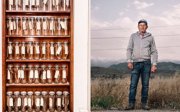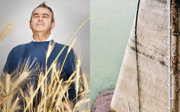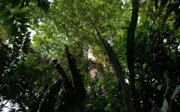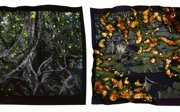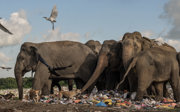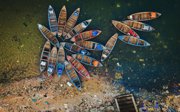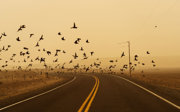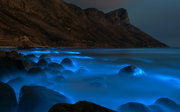
Earth Photo 2024
Out of 1,900 entries, 11 outstanding photography and film projects were chosen as the Earth Photo 2024 award winners.
The exceptional calibre of the winning photographers and filmmakers this year is indicative of how the Earth Photo project is going from strength to strength. Louise Fedotov-Clements, Head of Jury Earth Photo 2024, Director of Photoworks, and Forestry England Earth Photo Producer
Winner Earth Photo 2024
The overall winners of Earth Photo 2024 are Jean-Marc Caimi and Valentina Piccinni for their outstanding project Tropicala, which tells the story of farmers on Sicily and the quickly changing climate on the island.
"How the world will adapt to the new scenario of our planet can already be seen in the struggles of microcosms like Sicily, which has become the epicentre of the new tropical battle," Caimi and Piccinni explain.

Caimi and Piccinni: "As Europe experiences an unprecedented wave of extreme weather events, we documented the far-reaching consequences of climate change in Sicily. Rising temperatures, shifting rainfall patterns, and an increased risk of extreme events have transformed what was once Europe's breadbasket into a testing ground for adaptation and survival."
Climate of Change Award
We award the Climate of Change Award to projects that explore the impacts of climate change upon people, environments and wildlife. This year, the RGS selected Jennifer Adler for Corals of the Future.
Informed by a background in science focused on the impacts of climate change on marine ecosystems, Jennifer uses imagery to communicate science and conservation.
"In the summer of 2023, an extreme marine heat wave caused a mass coral bleaching event in the Florida Keys, a reef area that had already declined by 90 percent due to disease and past heat waves," Jennifer says.

This image shows Roxane Boonstra, examining a tree of healthy elkhorn coral (Acropora palmata) at the Coral Restoration Foundation’s Tavernier nursery, the world’s largest underwater coral nursery. The work overall tells a story that shows the resilience and innovative adaptations resulting in positive actions and changes towards our environment.
With their accessible and universal language, photography and film represent a formidable means for raising awareness that can encourage us to adapt, innovate and invent sustainable solutions in order to rethink our lives, society and economies.Louise Fedotov-Clements
Forest Ecosystem Award
Forestry England selected Marc Lathuillière as winner of the Forest Ecosystem Award for the film Ser Guardianes Madre Arbol (Becoming Guardians of Mother Tree).
The film was shot in the Bajo Atrato basin, a Biodiversity Zone in northern Colombia. This is one of the most humid and diverse areas on Earth, and the protection of its rainforest is intrinsically linked to the survival of hundreds of afro-descendant communities practising small-scale sustainable agriculture.
With support from the National Center for Visual Arts (Cnap, France) and AM Art Films, this video tells their story and that of their environmental group, the Guardianes Madre Árbol (Guardians of Mother Tree).

Invoking magical realism, this film testifies to the threats facing the community, and their non-violent resistance to the pressures of agro-industrialists and narco-paramilitaries, who seek to forcibly displace them, and appropriate and deforest their ancestral lands.
The Earth Photo 2024 Moving Image Award
The Earth Photo 2024 Moving Image Award goes to Zula Rabikowska for her short film The Border, which explores the ways nature and landscapes stand as political symbols, bearing human conflicts.
Zula revisits history with her grandfather, who was a child when Poland was occupied by Nazi Germany and the Soviet Union in 1939. Born in Poland and raised in the UK, Zula reflects on her heritage and identity, highlighting Eastern Europe's war-torn landscape, fluctuating borders, and conflicting identities. Zula retells the story from a personal and intimate perspective with her grandfather's help.

The Sidney Nolan Trust Residency Prize
The Sidney Nolan Trust Residency Prize goes to Pale Blue Dot Collective, Louise Beer and John Hooper for their innovative film Last Verse.
"Last Verse is a film made using footage and sound recorded in the Blue Mountains of Australia. The film depicts two temporalities of a non-human animal and from a cosmic time frame," explain the artists, and it poses the question whether "a cosmic perspective challenge our perception of the climate emergency."
David Wolf Kaye Future Potential Awards (DWKFPA)
The David Wolf Kaye Future Potential Awards is awarded to a photographer and a filmmaker aged 25 or under.
In the category Photo, Raymond Zhang, a fourteen-year-old student from Shanghai, China, has won for Walking on the Palette. This photograph, capturing the depths of the colour palettes within the landscape, documents a farmer walking along terraces found in Southern China.
Raymond notes: "I take photographs of scenery and people during my travel with my parents. I hope you like the stories behind the photos."

The David Wolf Kaye Future Potential Award - Film goes to Prahelika Deka for her work The Past, which depicts the ruins of homes after a disastrous cyclone in 1964 hit Dhanushkodi, on the Southern tip of Pamban Island of India.
"The work shows the consequences of our (in)actions as we are prompted to reflect on our choices in the face of a rapidly changing climate," says Prahelika. "What now remains a ghost town is a sobering reminder of the past and the lessons we can take forth from it."
Photoworks Digital Residency
The Photoworks Digital Residency Award goes to Marilene Ribeiro, whose selected series, Open Fire, tells the tale of a planet ablaze in response to the devastating forest fires that happen across the world.

Marilene explains: "On August 27, 2019, I read on BBC News Brazil: 'August 10th can be classified as a key moment in recent Amazon history. It is now known as the Day of Fire, when rural producers in the Brazilian Amazon are said to have started an organised movement to set fire to areas of the largest tropical forest in the world.'
"A few days after, the black smoke arrived in São Paulo, over 1,200 miles away from where the fire had taken place, and day became night in the largest city of the Americas."
New Scientist Editors Award
The New Scientist Editors Award, which gives a photographer the potential of an image spread in the Aperture section of the magazine, goes to Taylor Roades for Alaksa Rust Rivers. They will also receive mentoring with Tim Boddy, Picture Editor, New Scientist.

"During 2023, the hottest year on record, remote rivers in remote Arctic Alaska are turning bright orange with iron as permafrost thaw accelerates. There is no mining or human settlements for hundreds of miles of this location, so there is no other reason for this to occur other than climate change and rising temperatures," says Taylor.
This year’s winning images by photographers and filmmakers allow us to view anew through their lens, the beauty, fragility, crisis and change happening in our natural environment.Mike Seddon, Forestry England Chief Executive
The New Scientist Editors Award, for a filmmaker with the potential for an online video article goes to Breech Asher Harani, who will receive mentoring with David Stock, Head of Editorial Video, New Scientist.
Dreams of the Ravaged is a short docu-animation hybrid film about three young survivors of the most fatal super typhoons to hit the Philippines. They share their experiences and challenges dealing with extreme calamities, highlighting the harsh realities faced by communities already impacted by climate change.
National Trust Attingham Award
The National Trust Attingham Award for images that show the work or impact of volunteers protecting habitats under threat of climate change, goes to TJ Watt, co-founder of The Ancient Forest Alliance, for his photograph Flores Island Cedar.
The image depicts a gargantuan western red cedar that measures over 5m (17ft) wide near its base and is 46m (151ft) tall. Ahousaht Hereditary Leader, Tyson Atleo, stands at the base of the tree for scale.

Selection of shortlisted entries
The shortlisted and award-winning Earth Photo 2024 entries are available to see in the free Earth Photo 2024 exhibition, open at the Royal Geographical Society (with IBG), in London, until 21 August 2024.
The exhibit will also be on display at six Forestry England sites, four National Trust locations, at The Lost Gardens of Heligan, and the Sidney Nolan Trust.
We thank all photographers and filmmakers who submitted their incredible work for consideration in this year's Earth Photo.

Stay informed
We regularly host exhibitions as well as in-person and online events, including our Monday night lectures (members only) and regional events.
Would you like to stay up to date about our upcoming events and news? Log in, or create an account, and sign up for our newsletter.



